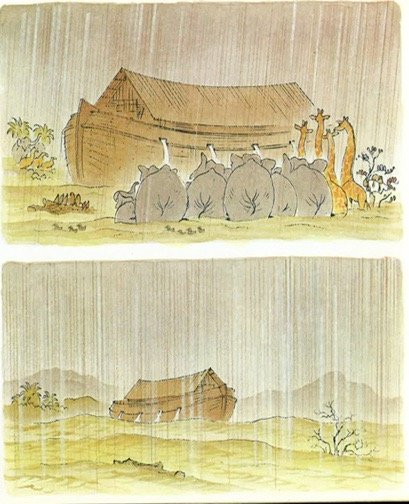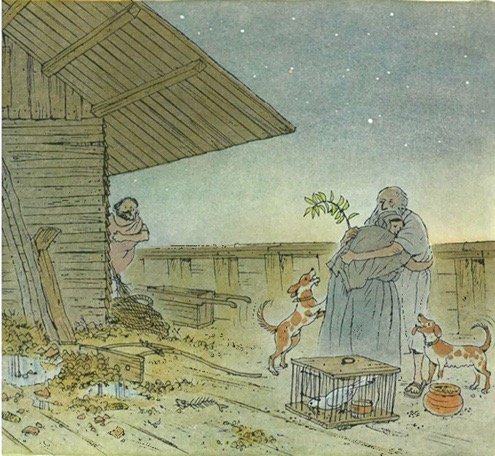Sadness and Hope
Friday night, October 24, 2020
Congregation B’nai B’rith, Santa Barbara CA
Early last Sunday morning I got to enjoy once again one of the best parts of my job. I went hiking with some of the children of our Netivot Jewish education program. Because of the need for Covid precautions, I am walking with very small groups, of a maximum of six children at a time. And in fact this is one of the silver linings of the pandemic, because with only 4 or 5 or 6 kids, it is much easier to keep track of them, and to spend the whole time in conversation with the whole group.
We started out early in the morning, at 8:00am last Sunday, just me and four little children and one intrepid mom, and we walked out on the Ellwood bluffs. It was so early that there was still a heavy marine layer of fog, and as we walked into the fog I said “this is just like when Moses went up to the top of Mount Sinai, and went into the cloud on top of the mountain, to speak with God.” They had a few good questions, and we continued on our walk. A little later, we sat down to eat our snacks and I said “OK now I want to tell you a story about the first human beings” and one of the kids, a kindergartner, declared “I love these God stories!” I was quietly rejoicing, but I also thought to myself, will she still love them when she hears the more disturbing God stories, like this week’s story…of Noah and the Flood.
When we tell that story of Noah to the kids, we make it fun. We sing “Rise and Shine.” “The Lord said to Noah, there’s gonna be a floody, floody….get those children out of the muddy, muddy, children of the Lord.” And each year we celebrate Noah Shabbat with costumes….even this year, earlier this afternoon we had the kids come in costume, in their cars, and at the end of tonight’s service we will show a short slideshow from this afternoon. We make the story fun, and think of what fun it must have been for Noah and his family in that floating zoo, with all the colorful animals. It is probably the best known and loved story….known and loved by children….in the entire Torah. But there is a deep sadness at the core of the story.
The only children’s book about Noah that I really love is by a Dutch artist named Peter Spier. The book won the Caldecott Medal and New York Times Best Illustrated Book of the Year, and the illustrations are in fact incredible. It is a book almost entirely without words, only page after page of gorgeous, detailed illustrations, which makes it perfect for a parent or grandparent or teacher to sit with, together with a child, and to bring the story to life simply by talking about what we see on the page. But I particularly love the book because of a single page, with a short set of illustrations. To describe that page, I’d like to read for you a negative review which I saw in on the website “Goodreads.” The reviewer feels very differently about this page than I do, but she describes it quite well, as follows:
“One page in particular is especially depressing for me, it's near the beginning. All the animals are boarding the ark two by two and after that there are still all these other animals waiting outside, just standing there because they didn't get to board the ark because they already had two of that kind. It starts to rain and then in the next picture half of the animals are gone and the other half (the tall ones) are mid-body length deep in water. And then the next picture? The animals are gone! The water is all around the ark and there are no animals. What do you say to a child that's been reading this?”
Let me show you that page.
I love that page, and especially because the entire book has no words. The illustrator allows us to just sit and look at that page in silence. That page captures all of the profound sadness of the Noah story. In truth, it captures all of the profound sadness of the world in which we live. I cannot imagine a better introduction for a child…or an adult for that matter…into the fact that this magnificent world, so full of beauty and majesty, is also full of suffering. And an appropriate first response is silence. Simply to sit together, parent and child, to bear witness to that suffering, and not try to say anything at all. Not try to make it better. Not try to explain that the suffering has a good reason. Just to see it and take it in.
Seeing that suffering, depicted with a clear and compassionate eye in a book telling the story of Noah’s flood seems to me a perfect way to introduce a child to the reality of suffering in our world.
Another profound teaching of the Noah story is that silence is not enough. Silence covers this story, like a blanket. I read the story for years before someone pointed out to me that in the entire narrative…and it is one of the longest stories in the entire Torah….in the entire story of Noah and the ark, Noah never says a word. We never hear him speak until long after he has come off of the ark. A later Jewish commentary, written long after the Torah, tells this story about Noah’s silence: In the moment that Noah came off of the ark, and gazed with horror upon all of the dead bodies, he cried out to God: “Lord of the universe! You are supposed to be merciful! Why have you not spared your children?” To which God replies: “Now you call out to Me? Before….when I announced to you that I was going to bring a flood, you said nothing. You took care of yourself and your family, and never said a thing. If you had cried out then, it would not have come to pass. But you knew that you would be spared, and just did not know what to say. So you said nothing.”
The Torah itself never openly condemns Noah for his silence, but all later Jewish generations have wondered: could Noah have spoken against God’s destructive plan, as Abraham did in his time, and as Moses did in his time?
In Noah’s defense, he worked hard. For a full year, on that ark, feeding and cleaning up after all those animals. Separating the predators from the prey, month after month after month. It was no picnic, and perhaps in telling the story, we should give credit to this man who worked all day and all night for an entire year, simply ensuring the survival of the remnant of earth’s inhabitants.
I was invited this week to speak at one of the local gatherings for Solidarity and Compassion, organized by the wonderful meditation teacher Radhule Weininger and Dr. Michael Kearney. They had chosen the topic “Prayers and stories to strengthen our heart.” Many of us, of course, are feeling in need of a little extra spiritual strength in these days of pandemic, and political strife, and economic dislocation. I chose to tell the Noah story, primarily because it is the Torah portion this week, and I honestly believe that every single Torah portion has the potential to strengthen our heart. But I think the Noah story in particular, read carefully, has the power to inspire hope.
One human family, together with the animals for which they have been made responsible, find themselves adrift in a world of only water….with no idea when or even whether they are ever going to get off of that ark again. They know they have been saved from the destruction of the flood….but for what? To float forever, in that prison? Landing on the mountaintop offers a tiny hope of something different, but the world is still water in every direction as far as the eye can see. Noah opens the window of the ark and sends forth a bird….a raven…that flies and flies and never returns. And when Noah releases the dove a week later, and the dove returns with nothing, I can only think that the disappointment must have been crushing. Finally, after one more week, Noah releases the dove again and this time after flying far, it returns with a tiny bit of green….the torn off leaf of an olive tree in its beak.
That tiny bit of green, a small leaf in the mouth of the dove, changes everything.
That leaf means that somewhere there is a tree, alive and growing.
The waters are receding.
The earth and all of life has a future.
All hope, all optimism are reborn…..all because of a tiny green leaf in the mouth of the bird.
Here is Peter Speir’s illustration of that moment:
This is the story that we Jews are telling this week, just as we have told it every year at this time, for three thousand years. I tell it to our kids, and to myself, because it reminds me that I am part of something old and vast.
I will tell it even to little children, because this story is a good way to learn that we human beings have seen trouble before; we have experienced countless times in which the world felt strange and unstable all around us.
The story of Noah’s flood, the dove, and the tiny olive leaf reawakening hope takes us on a journey
from prison to freedom,
from despair to courage
from silent acquiescence to acts of compassion.
Shabbat Shalom



